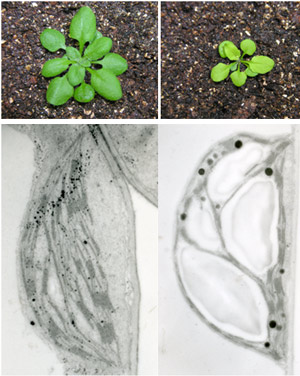Mar. 5, 2010 Research Highlight Biology
Plants on steroids
The identification of a gene involved in steroid hormone signaling in plants could benefit agriculture and reduce atmospheric carbon dioxide
 Figure 1: Photographs of a three-week old wild-type Arabidopsis plant (top left) and the pale green mutant (top right), bpg2, at the same age. Electron micrographs of normal (bottom left) and mutant (bottom right) chloroplasts isolated from these plants. The electron micrographs were taken by Chieko Saito of the Molecular Membrane Biology Laboratory, RIKEN Advanced Science Institute. Reproduced in part, with permission, from Ref. 1 © 2009 John Wiley and Sons
Figure 1: Photographs of a three-week old wild-type Arabidopsis plant (top left) and the pale green mutant (top right), bpg2, at the same age. Electron micrographs of normal (bottom left) and mutant (bottom right) chloroplasts isolated from these plants. The electron micrographs were taken by Chieko Saito of the Molecular Membrane Biology Laboratory, RIKEN Advanced Science Institute. Reproduced in part, with permission, from Ref. 1 © 2009 John Wiley and Sons
Working with Arabidopsis, a member of the cabbage family, a team led by Takeshi Nakano of the RIKEN Advanced Science Institute in Wako has identified a gene1, BPG2, that encodes a previously uncharacterized protein expressed by chloroplasts, the power houses of plant cells where energy from sunlight is harvested by the green pigment chlorophyll and used to build sugars for growth.
The researchers found that BPG2 is involved in signaling mediated by brassinosteroids, plant hormones related to steroid hormones of animals. In plants, these hormones have specific roles in growth and development of stems, leaves and roots. They are also involved in pollen tube growth required for sexual reproduction, and in senescence.
“Our identification of a chloroplast gene controlled by brassinosteroids demonstrates that these steroid hormones are also important for chloroplast regulation,” says Nakano.
Nakano and colleagues genetically screened some 10,000 Arabidopsis lines using a new chemical biology method and identified a pale green mutant (Fig. 1) that was insensitive to the acceleration of greening normally caused by Brz (brassinazole), a chemical that specifically inhibits the biosynthesis of brassinosteroids. This suggested the disruption of brassinosteroid-chloroplast signaling in the mutant plants and led to the identification of BPG2.
Further investigation revealed that chloroplast proteins normally induced by Brz failed to accumulate in the mutant plants. Electron microscope studies also showed that the structure of chloroplasts was abnormal in these plants.
The researchers then found that BPG2 expression is induced by light and Brz. The BPG2 protein is not directly involved in transcribing DNA to messenger RNA, the genetic template of protein. Instead, it regulates the processing in chloroplasts of molecular precursors of ribosomal RNA, the core component of the machinery called the ribosome that manufactures proteins.
A computer search of DNA sequence databases revealed that BPG2 -related genes occur in the genomes of other plants, including green algae, mosses and rice, and also in the common soil bacterium Bacillus subtilis.
Plants arose from a union of two organisms, including the bacterial ancestor of chloroplasts, which explains why chloroplasts have their own genomes.
“The fact that BPG2 -related genes are conserved in bacteria suggests that the BPG2 gene family arose early in the evolution of life on Earth,” explains Nakano. “We hope to genetically engineer plants to increase the expression of BPG2 so as to promote chloroplast and photosynthesis activity, which in future could potentially increase the productivity of agricultural crops and reduce the amount of carbon dioxide in Earth’s atmosphere.”
References
- 1. Komatsu, T., Kawaide, H., Saito, C., Yamagami, A., Shimada, S., Nakazawa, M., Matsui, M., Nakano, A., Tsujimoto, M., Natsume, M., Abe, H., Asami, T. & Nakano, T. The chloroplast protein BPG2 functions in brassinosteroid-mediated post-transcriptional accumulation of chloroplast rRNA. The Plant Journal 61, 409–422 (2009). doi: 10.1111/j.1365-313X.2009.04077.x
